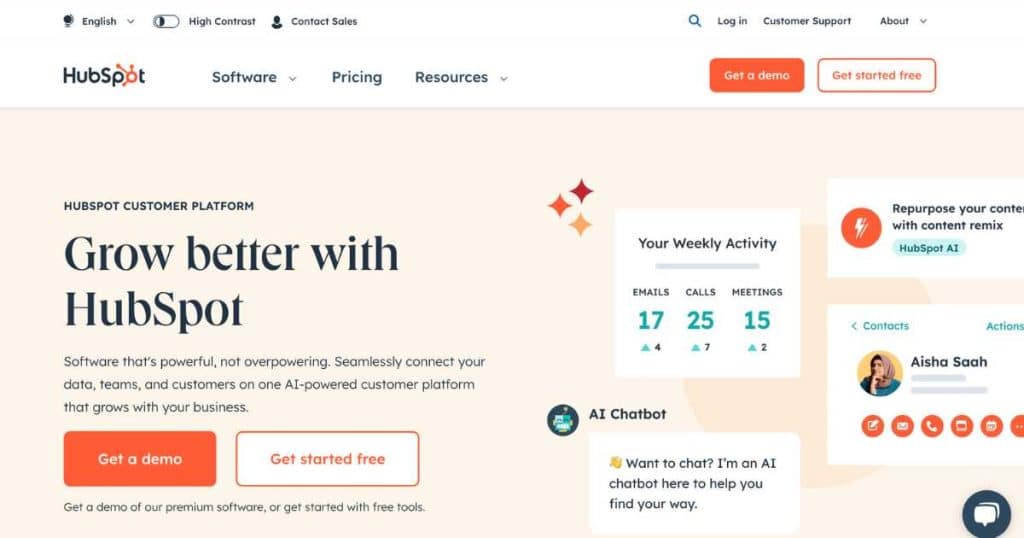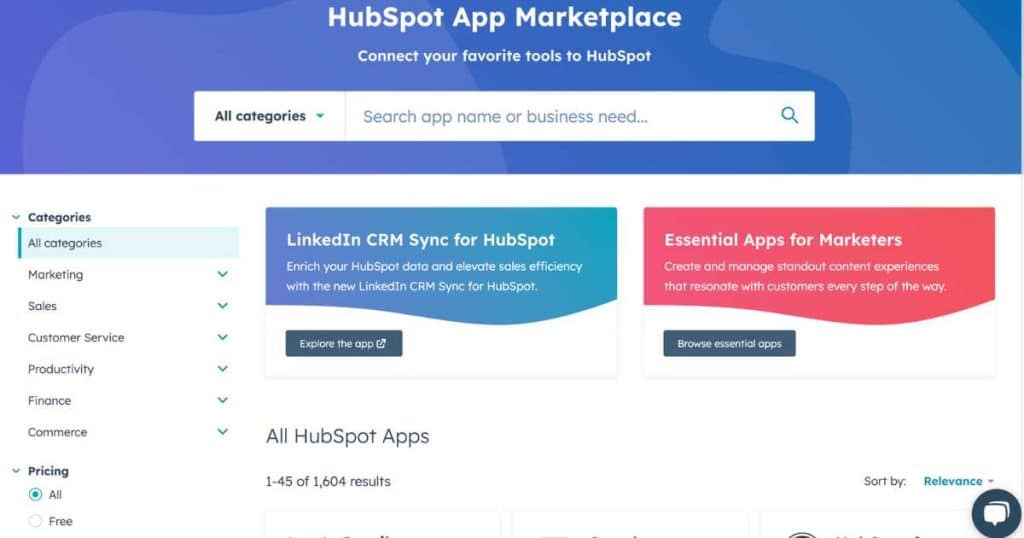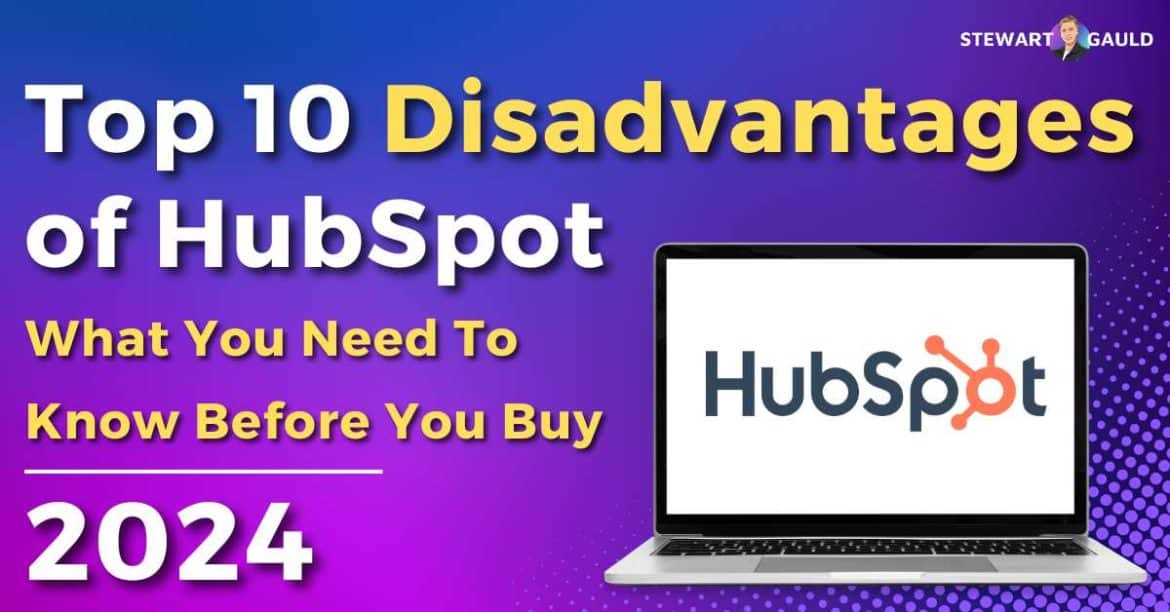In this comprehensive article, I delve into the top 10 disadvantages of HubSpot that you must know before you buy!
It’s no secret that HubSpot is a front contender within the world of marketing automation and sales CRM.
With an awesome free plan, powerful features, and a user-friendly interface, it’s no wonder so many users love and use HubSpot.
However, that doesn’t mean the platform doesn’t have its own set of CRM disadvantages!
Whether you’re completely new to the platform or currently use HubSpot’s free forever plan and want to know if it’s worth upgrading…..
I have you covered in this HubSpot limitations guide.
So, let’s talk about the not-so-sunny side of this leading tool right now.
Read more: 10 Disadvantages of HubSpot Free CRM
What Is HubSpot?

What is HubSpot?
HubSpot is an online software that combines marketing, sales, and customer service teams into one CRM database.
Basically, HubSpot’s products and solutions support lead generation, email campaigns, prospect engagement, operational growth, and more.
Features include a centralized CRM platform, marketing automation, email marketing, content management, social media analytics, lead tracking, and customer support.
If you’re looking for an all-in-one tool to supercharge your productivity, communication, and customer relationships, look no further than HubSpot!
HubSpot is pretty impressive. But like all online tools, there are pros and cons of HubSpot.
And in this guide, we’re here to talk about HubSpot’s limitations.
10 Disadvantages Of HubSpot

From effortlessly managing contacts and deals to keeping you on track with tasks and emails, HubSpot is many businesses’ ticket to success.
But is it the key to every successful business? The short answer is….no!
Sure, HubSpot is great, but there might be better choices for your organization!
Plus, you’re here to learn about HubSpot’s disadvantages.
So, what are they? Let’s find out.
Read more: 6 Best HubSpot Alternatives.
1. Complicated ‘Hub’ Pricing Plans
First up on my list of 10 disadvantages of HubSpot is their sheer number of plans!
When I first stumbled upon HubSpot’s pricing page, I was overwhelmed by the endless list of ‘Hub’ (plan) options.
If you’re unfamiliar with HubSpot, it might be difficult to determine whether you require a marketing, sales, service, content, commerce, or operations plan.
Plus, these different ‘Hubs’ also come with multiple tiers.
And if that wasn’t complex enough, you can also create your own custom bundle plan!
Now, don’t get me wrong—a custom bundle plan is awesome if you have unique needs.
But for those who just need a straightforward, ready-to-go plan, it only adds to the confusion.
This is why this HubSpot CRM disadvantage is at the top of the list.
Read more: 10 Advantages Of HubSpots Free CRM.
2. Additional Cost For Additional Users

This HubSpot disadvantage is short and sweet – you have to pay for additional users.
The price of additional users depends on which plan you opt for, and some plans offer limited seats.
For example, the ‘Marketing Hub Professional’ includes three seats.
If you have a large team, this can get pretty pricey quickly!
3. Pricing Plans Depend on the Number of Contacts
HubSpot’s pricing structure is based on the number of contacts you have.
Honestly, this is a pain if you have lots of contacts but only require a handful of features.
All pricing plans have contact limits unless you opt for the free plan (up to 1,000,000 contacts).
I actually found this pretty shocking considering the free plan’s limit is so generous!
Starter plans only come with 1000 contacts, and professional plans give you just 1000 more contacts.
And get this! Even Enterprise plans have a contact limit of 10,000!
In terms of paid pricing plans, this is a massive HubSpot limitation in my eyes.
Read more: HubSpot AI Content Assistant Review.
4. Expensive Paid Plans

As your business takes off, HubSpot’s price tag will skyrocket, too—and it can happen fast!
Unless you opt for the free plan (with limited features), you’ll need to upgrade to a paid plan, which can get expensive.
Starter plans are $15 a month, and professional plans can cost up to $800 per month.
And the Enterprise plan comes with a jaw-dropping price of $3200 per month!
As your business gains momentum and your contact list grows (and trust me, it will), be prepared for the costs to skyrocket with each upgrade.
5. Only Suitable For All-in-one Use
And we’re halfway through this HubSpot CRM disadvantages list!
This one is both a HubSpot pro and con.
Let me set things straight – I’m a big fan of HubSpot as an all-in-one business solution.
But what if you want to use only one of its many features? Well, that’s not really possible with HubSpot.
HubSpot is designed to be a comprehensive tool that covers everything under the sun, including building your website using its own CMS system.
But here’s the catch: shifting to HubSpot is a major headache if you’ve already built your website using a different CMS platform.
Plus, if you’re just after a simple CRM solution, HubSpot probably won’t give you the best bang for your buck.
If you just need a few specific features from HubSpot, you may be able to find a more affordable alternative solution that better suits your needs.
Read more: HubSpot’s Free Website Builder Review.
6. Paid Add-ons

Now, don’t get me wrong, HubSpot offers many useful free tools. But do they pack enough punch when it comes to actual functionality?
Well, some of the best features and functionalities are locked behind paid tiers.
This means users on free or low-tiered plans might have to dip into HubSpot’s App Marketplace to increase functionality.
Not only is this slightly frustrating, but it can also be quite costly!
I don’t know about you, but that sort of defeats the whole purpose of having an integrated CRM platform, doesn’t it?
Read more: How To Use HubSpot CRM Mobile App.
7. Limited Support For Free Plans
Another disadvantage of HubSpot for free CRM plan users is that there’s no access to live, dedicated support.
You’ll have to rely on the HubSpot Community, Knowledge Base, and Academy for assistance.
This isn’t ideal if you have any pressing technical issues or questions.
On the flip side, paying HubSpot users can contact HubSpot directly via phone or live chat.
However, upgrading to a paid plan may not be feasible for businesses on a budget.
Therefore, this is a huge HubSpot limitation.
8. Inflexible Contracts

Many other CRMs offer flexible month-to-month pricing terms, but not HubSpot.
Once you commit to a contract with HubSpot, whether for six or 12 months, there’s no turning back!
There’s also no ‘early termination’ fee or a ‘partial refund policy’ if you cancel your subscription before the contract period ends.
This rigidity can be a significant drawback, particularly for teams that only fully leverage some of HubSpot’s features.
Basically, even if you’re on a monthly billing cycle, you must continue paying until the total contract cost is met.
This lack of freedom is unsuitable for businesses looking for more flexibility within their CRM!
Read more: How To Create A Sales Pipeline With HubSpot?
9. No A/B Testing On Lower Tiered-Plans
For businesses, A/B (split) testing is a crucial tool that can help refine your marketing and sales efforts.
It involves testing two different versions of marketing ads, email subject lines, landing pages, etc, to see which performs the best with your target audience.
Many marketing platforms offer this feature on lower-paid plans.
But unfortunately, HubSpot’s split testing features are only available on higher-tiered packages.
Without access to these split testing functions, you could miss valuable opportunities to optimize your marketing campaigns effectively.
Read more: How To Use HubSpot Meeting Scheduler.
10. Limited Template Customization

And last on my list of HubSpot disadvantages is the lack of template customization ability.
Unless you’re familiar with CSS, you can only customize email templates to a certain extent, leaving you with stock-standard, unoriginal templates.
Many other platforms offer a more dynamic and user-friendly interface for creating and modifying email templates!
Stews Final Thoughts
And that concludes my article uncovering the top 10 disadvantages of HubSpot!
As you can see, it isn’t perfect. And there are certainly HubSpot pros and cons to consider before diving head first into the product.
However, I still believe that HubSpot is a standout CRM tool for many small-medium sized businesses.
This is because of its incredible features and impressive free plan.
Have you had the opportunity to experience HubSpot’s firsthand? What did you think?
Please share your thoughts and experiences with me below.

